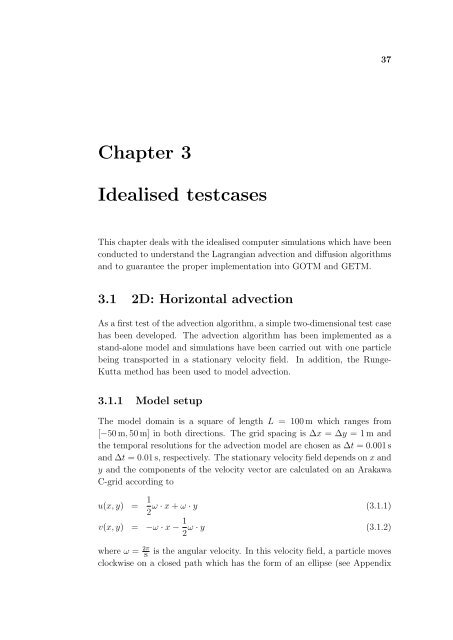Three-dimensional Lagrangian Tracer Modelling in Wadden Sea ...
Three-dimensional Lagrangian Tracer Modelling in Wadden Sea ...
Three-dimensional Lagrangian Tracer Modelling in Wadden Sea ...
You also want an ePaper? Increase the reach of your titles
YUMPU automatically turns print PDFs into web optimized ePapers that Google loves.
Chapter 3<br />
Idealised testcases<br />
This chapter deals with the idealised computer simulations which have been<br />
conducted to understand the <strong>Lagrangian</strong> advection and diffusion algorithms<br />
and to guarantee the proper implementation <strong>in</strong>to GOTM and GETM.<br />
3.1 2D: Horizontal advection<br />
As a first test of the advection algorithm, a simple two-<strong>dimensional</strong> test case<br />
has been developed. The advection algorithm has been implemented as a<br />
stand-alone model and simulations have been carried out with one particle<br />
be<strong>in</strong>g transported <strong>in</strong> a stationary velocity field. In addition, the Runge-<br />
Kutta method has been used to model advection.<br />
3.1.1 Model setup<br />
The model doma<strong>in</strong> is a square of length L = 100 m which ranges from<br />
[−50 m, 50 m] <strong>in</strong> both directions. The grid spac<strong>in</strong>g is ∆x = ∆y = 1 m and<br />
the temporal resolutions for the advection model are chosen as ∆t = 0.001 s<br />
and ∆t = 0.01 s, respectively. The stationary velocity field depends on x and<br />
y and the components of the velocity vector are calculated on an Arakawa<br />
C-grid accord<strong>in</strong>g to<br />
u(x, y) = 1<br />
ω · x + ω · y (3.1.1)<br />
2<br />
v(x, y) = −ω · x − 1<br />
ω · y (3.1.2)<br />
2<br />
where ω = 2π<br />
s is the angular velocity. In this velocity field, a particle moves<br />
clockwise on a closed path which has the form of an ellipse (see Appendix<br />
37

















